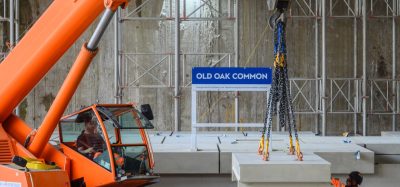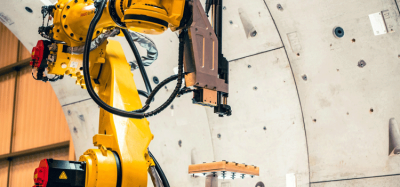A Swedish sustainable society
Posted: 15 September 2006 | | No comments yet
The Citytunnel in Malmö is an extensive project. To construct 17km of twin-track railway, 6km of which lie beneath central Malmö, more than 400,000m3 of concrete will be required. But the Citytunnel is not just one of Sweden’s largest ever infrastructure projects. It is also a pioneering project in terms of dealing with the environment as well as in terms of the relationship between client and contractors.
The Citytunnel in Malmö is an extensive project. To construct 17km of twin-track railway, 6km of which lie beneath central Malmö, more than 400,000m3 of concrete will be required. But the Citytunnel is not just one of Sweden’s largest ever infrastructure projects. It is also a pioneering project in terms of dealing with the environment as well as in terms of the relationship between client and contractors.
The Citytunnel in Malmö is an extensive project. To construct 17km of twin-track railway, 6km of which lie beneath central Malmö, more than 400,000m3 of concrete will be required.
But the Citytunnel is not just one of Sweden’s largest ever infrastructure projects. It is also a pioneering project in terms of dealing with the environment as well as in terms of the relationship between client and contractors.
On 8 March last year, Sweden’s Prime Minister, Göran Persson, pushed the button that marked the start of construction of the Citytunnel. Now, more than a year and a half later, work at several sites has gone 25m down into Malmö’s limestone and casting of the permanent structures, such as stations, cut-and-cover tunnels, and bridges has progressed. But a massive challenge remains – to bore the two parallel tunnels under central Malmö.
The start of construction had been preceded by many analyses, preliminary investigations, and hearings in the Environmental Court which delayed the start by several years. But this meant that the project had invested valuable time in preparation which served us well.
Collaboration
The Citytunnel Project involves many large and complex contracts. Full collaboration between client and contractors is critical for the success of the project. It is easy to get caught in a traditional adversarial relationship which inherently works against the project. In The Citytunnel Project, therefore, collaboration and knowledge transfer are keywords, and we try to see the roles that occur in a large construction project in a new perspective. I feel it is important to work together and to avoid focusing on differences and different roles.
Unique environmental testing
I would say that the Citytunnel is Sweden’s most environmentally-tested project. In addition to the hearings in the Environmental Court, an extensive description of the consequences on the environment was drawn up. This covered all environmental effects during the construction phase as well as the operation phase. The project was also subjected to a voluntary environmental survey in which everyone who is in any way involved had the possibility of affecting conditions in a secure legal process.
The investigations and surveys that formed the basis of the description of the consequences on the environment and the voluntary part as well will prove useful to the environment. The Citytunnel Project will also benefit because the environmental verdict gives us a very clear framework in which to work. We now have the right to affect the environment during the construction and operation phases under controlled and regulated forms. I am also convinced that the lessons learned from the project will prove useful to the construction industry in general and society as a whole.
Groundwater and vibrations
It became apparent quite early that Malmö inhabitant’s main concerns were lowering of the ground water table and that vibrations from excavations and tunnel-boring would cause settlements and cracks in buildings.
To check settlements of the ground and in buildings, more than 1,200 dowels have been placed in buildings in the central Malmö region, forming surveying points that will be checked regularly during and after construction.
At work sites, it is necessary to lower the ground water table during the construction phase. Some excavations go down to 25m below ground level. A system of wells and pumps makes sure that the ground water table is lowered only in the area covered by the Environmental verdict. Groundwater is pumped out through extraction wells near the excavation and re-injected into limestone rock some distance away. During the project, the groundwater extraction rate is around 1,000m3 per hour.
During the construction phase, regular checks are made to ensure that contractors and all others involved keep to the Environmental verdict on emissions, noise, vibrations, and use of chemicals. Every chemical used in the project has to be scrutinised, and contractors have to obtain our approval before they can use it. So far, we have checked over 1,000 chemicals.
Opening up a dead end
When the Citytunnel is finished, 85% of all trains from north to Malmö will proceed southwards through the Citytunnel on to Ystad, Trelleborg, or Copenhagen via the Öresund Bridge. Two completely new stations will be built and Malmö C will be extended with a new underground section.
Malmö C will have a totally new function in that it will be extended and converted from a terminal station – one in which all trains have to turn around – to a modern station for through traffic. The new underground section will have four tracks and two island platforms.
The station is built using the cut-and-cover technique. A long ramp leads the rail tracks from the marshalling area at the eastern end to the underground station and on to a diverging section connected to the tunnels bored at the western end.
New underground station
The Triangeln Station will lie between the southern part of Malmö’s commercial centre and the Malmö University Hospital, the largest workplace in Scania. Within walking distance of this station are the Malmö Opera and Music Theatre, the City Art Gallery, Malmö Sports Ground, Malmö University, as well as the city’s largest shopping street, the shopping mall, 18,000 jobs and housing for 23,000.
The Triangeln Station will be one of Sweden’s largest stations in terms of number of people using it. According to our estimates, approximately 37,000 people will pass through it each day on their way to and from work, cultural events, sports, and entertainment.
The station will be built roughly 25m below ground level and will have two entrances with escalators, lifts, and technical rooms. It will be approximately 25m wide and 6m high, and will have space for two tracks plus a platform 250m long and 14.5m wide.
Historical breakthrough
The rock cavern for the Triangeln Station is being built from two deep pits which will later become staircases. A central pillar tunnel was excavated from both these pits. On 8 July, there was a historical breakthrough and the two pits were connected by the tunnel which will later become the station. The tunnel-excavation work has so far been successful and the breakthrough took place on schedule. This confirmed that we were on the right track and that the extensive geological investigations carried out before construction began had been worthwhile. The experience of underground working at Triangeln also provided us with useful knowledge before work continues on the twin tunnels.
Permanent works are now being cast in the central pillar tunnel, consisting of base slab and top beams with load bearing pillars. On both sides of the central tunnel, the cavern is being progressively extended supported with bolts and reinforced shot-crete.
When all the limestone is removed, permanent concreting will commence to give the station its final form. Spaces for escalators, lifts, technical rooms, platform, and ventilation will then be cast. Finally, tracks and station equipment will be installed.
A new city district
The third station, Hyllie, lies right after the tunnel mouth in southern Malmö, and will form the centrepiece of the new Hyllie urban area planned by Malmö City. The urban area will be arranged so that the station will form a natural centre close to a large events arena, a shopping centre, housing and areas for businesses and services.
The Citytunnel line will pass through this part of the city in a cutting, which reduces noise while allowing safe overpass crossings with road traffic in the area. The station is partly covered and has four tracks and two 350m platforms. The tracks themselves lie approximately 7m below the local ground level. The massive cover allows passage over the rail tracks.
West of Hyllie station, an overpass track crossing as well as a linking track to the Öresund line is being constructed. Traffic is led westwards to the Öresund Bridge and Copenhagen, and eastwards to the lines to Trelleborg and Ystad. Altogether, approximately 15 new bridges are being constructed in southern Malmö.
Bored tunnels
A major challenge in The Citytunnel Project is the construction of the parallel tunnels under central Malmö. They will be 6km in length, of which 4.5km will be bored using two tunnel boring machines, a technique which is unusual in Sweden. The two machines are manufactured by Herrenknecht AG of Schwanau, Germany, and will be delivered during the autumn. They will be assembled at Holma in southern Malmö.
The cutter heads have a diameter of almost 9m and including the service trains that follows the machines, the total length is 120m. The machines seal the tunnels permanently by continuously lining them with prefabricated concrete segments inside the watertight shield at the front of the machine. To line the whole tunnel, approximately 40,000 segments will be used, forming an assembly of over 5,000 tunnel rings. The concrete segments are cast in a factory right opposite the tunnel mouth at Holma.
From the time that boring starts, estimated to be at the turn of the year 2006/2007, the work is estimated to take almost two years, which means that the machines should reach Malmö Central at the end of 2008.
Strict requirements on concrete
To create the Citytunnel and construct the stations and bridges forming part of the project, a total of over 400,000m3 of concrete is required.
The saline water of the Öresund affects the groundwater which again affect the tunnel, and the continuous oscillation (around zero degree during winter in southern Sweden) affects the service life of the concrete. Nevertheless, the requirement is that it should have a service life of 120 years. Safety in the finished tunnel also requires that the concrete should be able to stand temperatures up to 1,300ºC. Because concrete contains water, there is a risk of spalling at high temperatures when the water evaporates. To minimise the spalling, plastic fibres are embedded in the concrete which melt and allows the steam to evaporate from the concrete.
Safety
The Citytunnel is designed to high safety standards. Several risk analyses and studies were carried out before construction began in order to identify and assess all risks.
No diesel trains will be permitted in the Citytunnel, and freight transport will normally be excluded. This means that a number of risk factors, such as hazardous goods are eliminated. All trains that pass through the Citytunnel must install emergency-brake blocking so that if the emergency brake is operated in a tunnel the train will be driven out of the tunnel to the nearest station for evacuation. The train will be driven to the nearest station even in the event of fire.
Stations are designed to handle rapid and safe evacuation. Passengers will receive information via loudspeakers on platforms and in trains. Smoke will be extracted through fire culverts in the ceilings and escalators are kept smoke-free with glazing and pressurisation.
If a train cannot be driven to the nearest station, rescue services can carry out actions in the Citytunnel via two access shafts set between stations. There are also 13 cross tunnels for underground evacuation, located at intervals of up to 360m. Monitoring cameras are located in all cross tunnels and at all stations and within the tunnels, there are walkways along the tunnel walls and track.
A well-run organisation is another important safety factor. Safety work has been in progress since the project began, and there have been continuous discussions with the authorities. Rescue services will be prepared for action in tunnels and stations.
New Malmö
When the Citytunnel is complete, Malmö will look entirely different. Even central Malmö itself will be changed, with a new station at Triangeln and a totally new cityscape around Malmö C. But the Citytunnel will have its main focus on travelling times. It will be easier for people from western Scania to commute to work or for entertainment and shopping, all of which will reduce vehicle usage with a positive effect on the environment. Regional rail traffic can be extended and many places in Scania will come within the reach of commuter trains. Also, Öresund traffic will be linked more effectively with regional traffic, and national rail traffic will be improved when long-distance trains can pass through Malmö more easily. Overall, it will be easier and safer to travel in Malmö and Scania.







